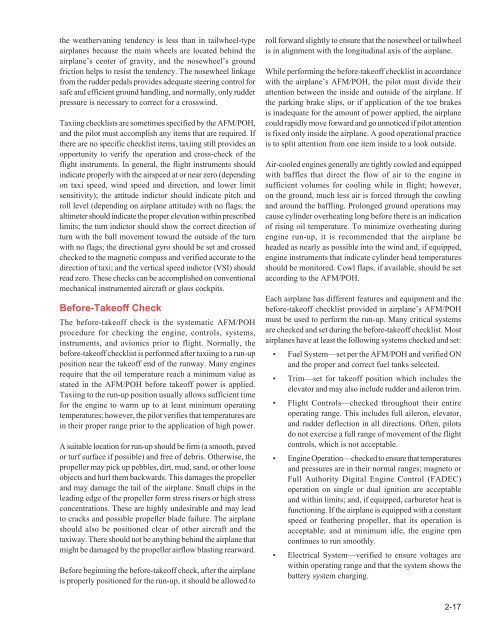Create successful ePaper yourself
Turn your PDF publications into a flip-book with our unique Google optimized e-Paper software.
the weathervaning tendency is less than in tailwheel-type<br />
airplanes because the main wheels are located behind the<br />
airplane’s center of gravity, and the nosewheel’s ground<br />
friction helps to resist the tendency. The nosewheel linkage<br />
from the rudder pedals provides adequate steering control for<br />
safe and efficient ground handling, and normally, only rudder<br />
pressure is necessary to correct for a crosswind.<br />
Taxiing checklists are sometimes specified by the AFM/POH,<br />
and the pilot must accomplish any items that are required. If<br />
there are no specific checklist items, taxiing still provides an<br />
opportunity to verify the operation and cross-check of the<br />
flight instruments. In general, the flight instruments should<br />
indicate properly with the airspeed at or near zero (depending<br />
on taxi speed, wind speed and direction, and lower limit<br />
sensitivity); the attitude indictor should indicate pitch and<br />
roll level (depending on airplane attitude) with no flags; the<br />
altimeter should indicate the proper elevation within prescribed<br />
limits; the turn indictor should show the correct direction of<br />
turn with the ball movement toward the outside of the turn<br />
with no flags; the directional gyro should be set and crossed<br />
checked to the magnetic compass and verified accurate to the<br />
direction of taxi; and the vertical speed indictor (VSI) should<br />
read zero. These checks can be accomplished on conventional<br />
mechanical instrumented aircraft or glass cockpits.<br />
Before-Takeoff Check<br />
The before-takeoff check is the systematic AFM/POH<br />
procedure for checking the engine, controls, systems,<br />
instruments, and avionics prior to flight. Normally, the<br />
before-takeoff checklist is performed after taxiing to a run-up<br />
position near the takeoff end of the runway. Many engines<br />
require that the oil temperature reach a minimum value as<br />
stated in the AFM/POH before takeoff power is applied.<br />
Taxiing to the run-up position usually allows sufficient time<br />
for the engine to warm up to at least minimum operating<br />
temperatures; however, the pilot verifies that temperatures are<br />
in their proper range prior to the application of high power.<br />
A suitable location for run-up should be firm (a smooth, paved<br />
or turf surface if possible) and free of debris. Otherwise, the<br />
propeller may pick up pebbles, dirt, mud, sand, or other loose<br />
objects and hurl them backwards. This damages the propeller<br />
and may damage the tail of the airplane. Small chips in the<br />
leading edge of the propeller form stress risers or high stress<br />
concentrations. These are highly undesirable and may lead<br />
to cracks and possible propeller blade failure. The airplane<br />
should also be positioned clear of other aircraft and the<br />
taxiway. There should not be anything behind the airplane that<br />
might be damaged by the propeller airflow blasting rearward.<br />
Before beginning the before-takeoff check, after the airplane<br />
is properly positioned for the run-up, it should be allowed to<br />
roll forward slightly to ensure that the nosewheel or tailwheel<br />
is in alignment with the longitudinal axis of the airplane.<br />
While performing the before-takeoff checklist in accordance<br />
with the airplane’s AFM/POH, the pilot must divide their<br />
attention between the inside and outside of the airplane. If<br />
the parking brake slips, or if application of the toe brakes<br />
is inadequate for the amount of power applied, the airplane<br />
could rapidly move forward and go unnoticed if pilot attention<br />
is fixed only inside the airplane. A good operational practice<br />
is to split attention from one item inside to a look outside.<br />
Air-cooled engines generally are tightly cowled and equipped<br />
with baffles that direct the flow of air to the engine in<br />
sufficient volumes for cooling while in flight; however,<br />
on the ground, much less air is forced through the cowling<br />
and around the baffling. Prolonged ground operations may<br />
cause cylinder overheating long before there is an indication<br />
of rising oil temperature. To minimize overheating during<br />
engine run-up, it is recommended that the airplane be<br />
headed as nearly as possible into the wind and, if equipped,<br />
engine instruments that indicate cylinder head temperatures<br />
should be monitored. Cowl flaps, if available, should be set<br />
according to the AFM/POH.<br />
Each airplane has different features and equipment and the<br />
before-takeoff checklist provided in airplane’s AFM/POH<br />
must be used to perform the run-up. Many critical systems<br />
are checked and set during the before-takeoff checklist. Most<br />
airplanes have at least the following systems checked and set:<br />
• Fuel System—set per the AFM/POH and verified ON<br />
and the proper and correct fuel tanks selected.<br />
• Trim—set for takeoff position which includes the<br />
elevator and may also include rudder and aileron trim.<br />
• Flight Controls—checked throughout their entire<br />
operating range. This includes full aileron, elevator,<br />
and rudder deflection in all directions. Often, pilots<br />
do not exercise a full range of movement of the flight<br />
controls, which is not acceptable.<br />
• Engine Operation—checked to ensure that temperatures<br />
and pressures are in their normal ranges; magneto or<br />
Full Authority Digital Engine Control (FADEC)<br />
operation on single or dual ignition are acceptable<br />
and within limits; and, if equipped, carburetor heat is<br />
functioning. If the airplane is equipped with a constant<br />
speed or feathering propeller, that its operation is<br />
acceptable; and at minimum idle, the engine rpm<br />
continues to run smoothly.<br />
• Electrical System—verified to ensure voltages are<br />
within operating range and that the system shows the<br />
battery system charging.<br />
2-17


